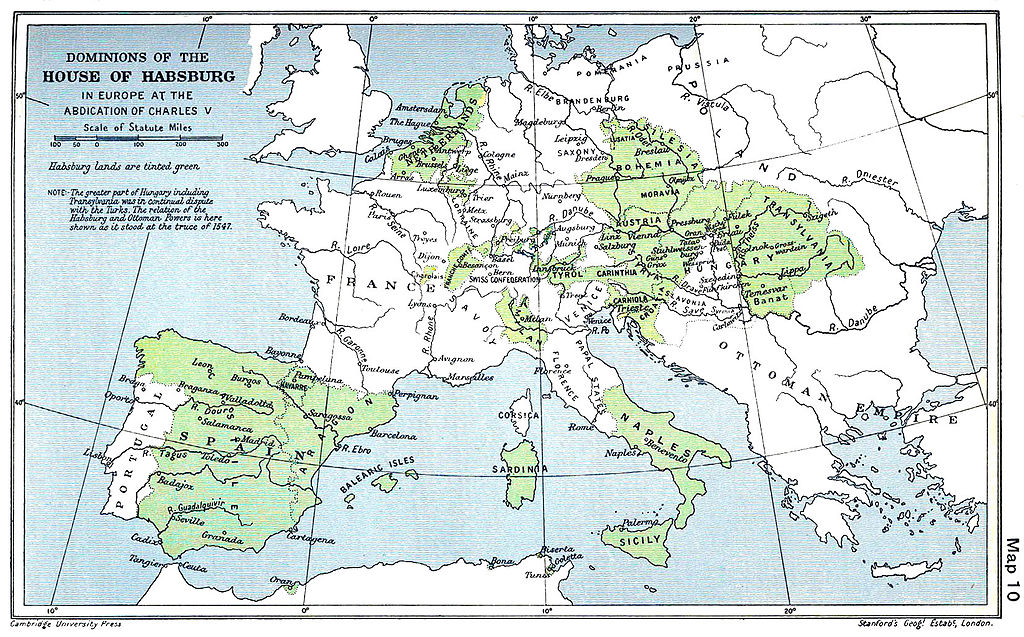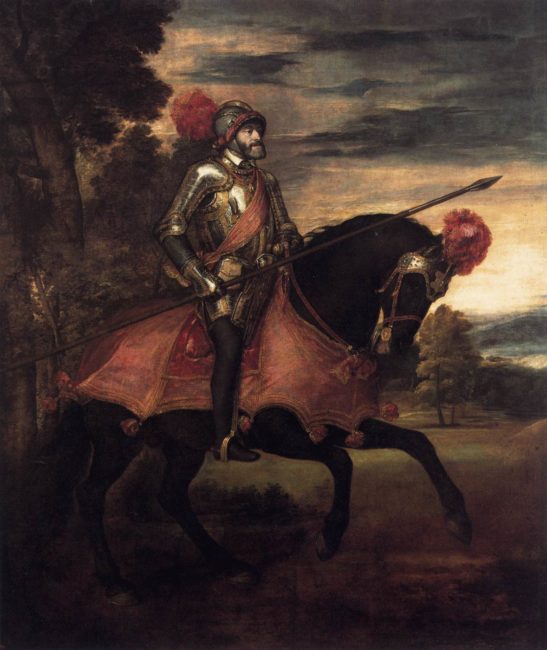Spain and the Politics of Charles V/Carlos V (ruled 1516-56).
When Isabella and Ferdinand, heirs respectively to the crowns of Castile and Aragon (which included Catalonia, the kingdom of Naples, Sicily, Sardinia), married in 1469, they laid the foundations of Spain’s Golden Age. They left a country politically united, imposed religious uniformity and, thanks to the discovery of America (Las Indias) by Christopher Columbus, launched Spain on its imperial journey.
Charles ruled for 40 years (1516-56) and was the first king of both Castile and Aragon (hence Charles I of Spain). However, he was not born in Spain but in Flanders (in1500), and was already a teenager when he first arrived in Spain in 1517. As a stranger, he inevitably faced problems of adjustment during the early years, but he was astute and learned quickly.
We’ll look at the politics of his reign in five general areas, each of which overlapped to some degree: 1. The early years; 2. Territorial expansion; 3. Charles’s election as Holy Roman Emperor; 4. The Mediterranean; 5. Political enemies.
The Early Years: 1516-20.
When the teen-aged Charles I arrived in Spain in 1517, there were immediate and grave problems. First, he was not a Spaniard by birth, could not speak Spanish (he grew up in Flanders speaking Flemish and French), and was largely ignorant of Spanish affairs. Second, he surrounded himself with Flemish advisers who did little to endear themselves to the Spanish people both by their self-interest and by the positions of wealth and power they acquired in the Spanish court.
The demands of the comuneros are revealing: among other things, they wanted the king to return to Spain, remove foreigners from court positions, learn Spanish, conform more to the customs of the Catholic Kings, and call Cortes to meet every three years.
Charles could not ignore what had happened and was politically astute enough to recognise that some changes were necessary. He started off on a good footing by granting a general amnesty to most of those who had participated in the revolt, allowed the rebellious towns to retain their privileges, reduced his dependence on foreign advisers in favour of Castilians and learned Spanish. And he spent the next seven years (1522-1529) in Spain, the longest uninterrupted period he was to spend in the country.
Territorial Expansion.
Under Charles, Spain’s territorial horizons expanded significantly.
As heir to Hapsburg lands, Charles brought under Spanish rule large chunks of territory in Europe, including the Netherlands, parts of Burgundy, Austria. In 1519, the German states were added when Charles was elected Holy Roman Emperor, and in 1535 he acquired the Duchy of Milan.
Across the Atlantic, Hernán Cortés conquered Mexico (1519-21) and Francisco Pizarro overcame the Incas of Peru (1532-33). Between 1519 and 1522 five Spanish ships, under the Portuguese captain Fernando Magellan, became the first to circumnavigate the globe. (Magellan was killed in the Philippines, and of the five ships only one -appropriately called the Victoria- made it back to Spain.)

It was a heady period as the Spanish empire –or more correctly the monarquía española— expanded but it was a widely scattered conglomeration and the only link that held it together was Carlos.
The costs of controlling that scattered conglomeration were enormous, especially with the constant wars that Charles found himself embroiled at different times: in France, Germany, Italy, the Mediterranean and North Africa.
It might be easy to conclude that it was the fabled gold and silver of The Indies that paid the enormous bills. They helped but even so were insufficient to meet all the king’s needs. Indeed, all the sources Charles had available (e.g. taxes, state annuities, church contributions, sales of hidalguía) were not enough to cover the costs.
Hidalgos enjoyed many privileges,
including exemption from paying
direct taxes.
This left Charles with only one other recourse: that was to borrow money. Here we come to a conundrum. Thanks to the expulsion of the Jews in 1492, there were very few financiers wealthy enough in Spain to advance money to Charles, so that he was forced to call upon German and Genoese bankers. And how were these bankers persuaded to hand over their money? It was on the promise of future bullion from The Indies.
In other words, Charles was mortgaging the country’s future with the result that much of the gold and silver was then committed to repay foreign lenders, and simply passed through Spain on its way to Germany and Genoa. It had a devastating impact on Spain’s economy well into the 17th century.

Holy Roman Emperor 1519-1558.
In 1519 Charles was elected Holy Roman Emperor, a title which cost him—or Castile—a vast sum of money. The election had profound consequences for Spain. Charles now carried two titles on his shoulders: Charles V of the Holy Roman Empire and Charles I of Spain, but his selection of the former title as the pre-eminent one clearly signals the order of priorities for him.
With the defeat of the comuneros, and the consolidation of his power, Charles was free to attend to his imperial duties which were to defend the papacy and the interests of the Catholic Church on an international level. Spaniards may have initially kicked at his preoccupation with Europe, but Charles won them over by identifying them increasingly with the mission of defending Catholicism.
His struggle with the threatening spectre of heretical Protestants in Northern Europe touched a common chord and recalled the crusading spirit of the Reconquista, which was still relatively fresh in the collective Spanish memory. The result was that Spain became increasingly embroiled in events in Northern Europe. And it was in this arena that Charles spent most of his time; in fact of the 40 years he ruled, he spent only 16 in Spain, and in the last 13 years of his reign he did not set foot in the country at all!
The Mediterranean.
Charles was also busy in the Mediterranean. Here a resurgent Islam, led by the Suleiman the Magnificent (b1495-d1566), was a constant reminder of the need for vigilant defence of the faith everywhere. Suleiman was a youthful, larger-than-life Turk whose rule –1520 to 1566, roughly the same period as Charles — marks a high point in the long history of the Ottoman Empire. Under Suleiman, Muslim forces overran the Balkans and by 1529 were laying siege to Vienna, the very seat of the Hapsburg dynasty. Only a spirited defence, in which Spanish soldiers played a prominent part, prevented the city falling into Muslim hands.
At sea, the Ottoman navy made its presence felt throughout the Mediterranean. Spain’s policy following the conquest of Granada (1492) had been to set up garrisons along the North African shore but they did not, however, establish firm command.
Under the famous privateer Barbarossa, the Ottomans made life difficult for Spain. Garrisons fell, were retaken only to fall again. For example, Barbarossa seized Tunis in 1534. Charles retook it in 1535. After Charles’s death, Tunis fell again to Muslim forces in 1569 then to the Christians in 1573 and finally back definitively to the Muslims in 1574.
By the end of the 16th century, Spain was left with only four garrisons, Melilla, Oran, Mers-el-Kebir and Ceuta (Ceuta was added only in 1580 when Philip/ Felipe II succeeded to the Portuguese throne and Portugal’s possessions -which included Ceuta- became part of the Spanish empire. Melilla and Ceuta remain Spanish enclaves today. Oran and Mers-el-Kebir were lost in 1792).
Political Enemies:

One of the reasons why Spain was unable to exert firm control on the North African coast was its commitments to Europe. The Protestant heresy required Charles’s full attention, but his concerns were not limited to battles against heresy. Even within the Catholic fold not all was unanimity.
There were those who feared that Charles harboured ambitions to become a “universal” monarch, an idea widely booted about and given substance by Charles’s growing empire. This clearly touched a political nerve and nowhere more so than in France whose king, Francis I, like Charles, was a young, energetic and enterprising ruler.
The rivalry between the two countries was historical (part of Fernando and Isabel’s foreign policy had been to surround France), but it so happens that Francis had also been a contender for the title of Holy Roman Emperor, so that the national rivalry sometimes seemed to take on a personal tone.
Charles, however, had the upper hand. After the battle of Pavia (over the control of Northern Italy) in 1525, the defeated Francis was hauled to Spain (Madrid) and forced to cede territory in Burgundy (which had been annexed by France in 1477) to Charles in return for his freedom.
Besides being constantly at odds with France, Charles had to check the spread of Lutheranism in the Netherlands and pacify the rebellious Protestant princes of the German States. It was difficulties with the latter that eventually lead Charles to accept a division of the empire. In 1552, he agreed that with his death the Imperial title should pass to his younger brother, Fernando, together with the Austrian-German lands that came with it.
The loss of these lands made the defence of the Netherlands –his birthplace- even more crucial for him; it was with this in mind that he arranged the marriage in 1554 of his son and heir, Philip/Felipe, with Mary Tudor, Queen of England (who had returned England to the Catholic fold).
Charles’s endless travels throughout Europe and the Mediterranean give the impression of dynamism; he was everywhere and no political decision could be made without considering Spain’s reaction. With such a dynamic king at the helm, and with Spain at the hub of a vast empire, the destiny of the country seemed unlimited.
But the costs of war were onerous and fell mainly on Spain, especially Castile. The burden of empire finally proved too much for Charles, and in 1556, suffering from ill health and gout, he abdicated in favour of his son, Philip, and retired to the isolated monastery of Yuste, in Extremadura, where he died two years later.
Sources.
Elliott, J.H Imperial Spain 1469-1716 London 1963
Kamen, Henry Spain 1469-1714: A Society in Conflict London 1983
“ “ Golden Age Spain Atlantic Highlands NJ 1988
Pagden, Anthony Lords of all the World New Haven and London 1995
Map of Charles V’s European possessions: https://commons.wikimedia.org/wiki/Atlas_of_Spain
Images of Charles V: https://en.wikipedia.org/wiki/Charles_V,_Holy_Roman_Emperor
Map including Spain’s empire ca 1550: https://commons.wikimedia.org/wiki/Atlas_of_colonialism
